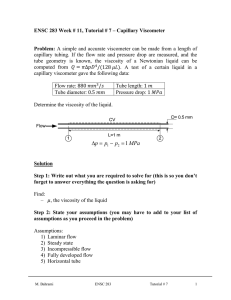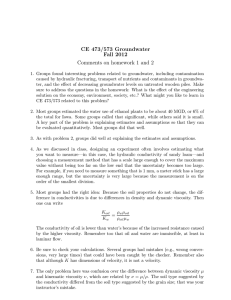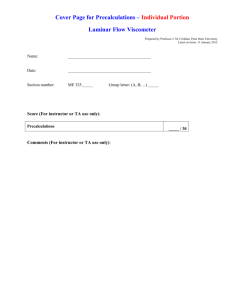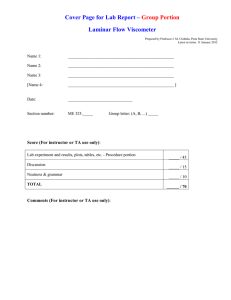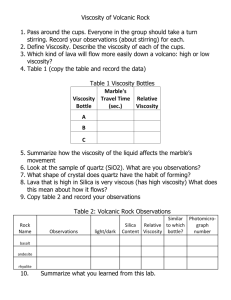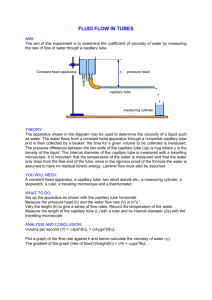VISCOSITY OF WATER BY CAPILLARY FLOW
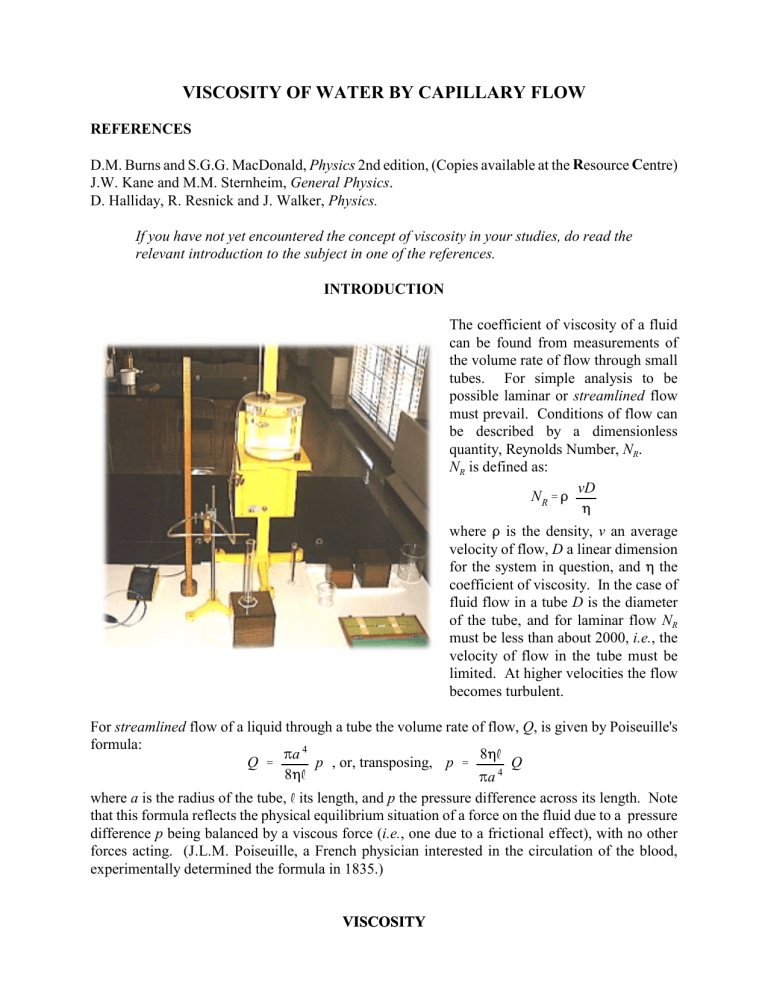
VISCOSITY OF WATER BY CAPILLARY FLOW
REFERENCES
D.M. Burns and S.G.G. MacDonald, Physics 2nd edition, (Copies available at the Resource Centre)
J.W. Kane and M.M. Sternheim, General Physics.
D. Halliday, R. Resnick and J. Walker, Physics.
If you have not yet encountered the concept of viscosity in your studies, do read the relevant introduction to the subject in one of the references.
INTRODUCTION
The coefficient of viscosity of a fluid can be found from measurements of the volume rate of flow through small tubes. For simple analysis to be possible laminar or streamlined flow must prevail. Conditions of flow can be described by a dimensionless quantity, Reynolds Number, N
R
.
N
R
is defined as: vD
N
R where is the density, v an average velocity of flow, D a linear dimension for the system in question, and the coefficient of viscosity. In the case of fluid flow in a tube D is the diameter of the tube, and for laminar flow N
R must be less than about 2000, i.e., the velocity of flow in the tube must be limited. At higher velocities the flow becomes turbulent.
For streamlined flow of a liquid through a tube the volume rate of flow, Q, is given by Poiseuille's formula:
Q a
4
8
# p , or, transposing, p
8
#
Q a
4 where a is the radius of the tube,
#
its length, and p the pressure difference across its length. Note that this formula reflects the physical equilibrium situation of a force on the fluid due to a pressure difference p being balanced by a viscous force (i.e., one due to a frictional effect), with no other forces acting. (J.L.M. Poiseuille, a French physician interested in the circulation of the blood, experimentally determined the formula in 1835.)
EXPERIMENT
The flow of water, Q, is to be measured at several values of p and for two or three different capillary tubes (available at the
Resource Centre). The pressure p depends on the head of water, i.e., the height of the water in the reservoir above the level of the tube. The length of the tube can be readily found. The radius is more difficult to find.
It has been measured for you by introducing a thread of mercury into the tube, determining its length and then its mass (and hence volume). The resulting values of the radii of the tubes are provided.
The viscosity of water changes rapidly with temperature (See tables in the references.). Measure the temperature of the water at the beginning and end of the lab period. If there is a difference, estimate the error this introduces into your determination of the viscosity.
CORRECTIONS
There are several empirical corrections that have been made to the Poiseuille formula. In particular a dynamical correction may be worth making in this experiment. It can be represented as follows: p
8
# a
4
Q m a
4
Q
2
The first term on the right hand side is from the Poiseuille formula and the second term is the correction. The value of the parameter m for a given tube may be found by plotting p/Q versus Q to obtain a straight line, or by using the computer fit to a p versus Q plot. For your data, roughly how big is the correction term relative to the first term in the equation? (Find numerical values for the two terms for typical Q values. What percentage of the first term is the correction term?)
UNITS
The C.G.S. unit of viscosity is the poise. The viscosity of water at room temperature is about one centipoise. The S.I. unit could be expressed as N.s.m
-2
, but is not yet in common use.
(revised jbv - 89, tk -98)
VISCOSITY

